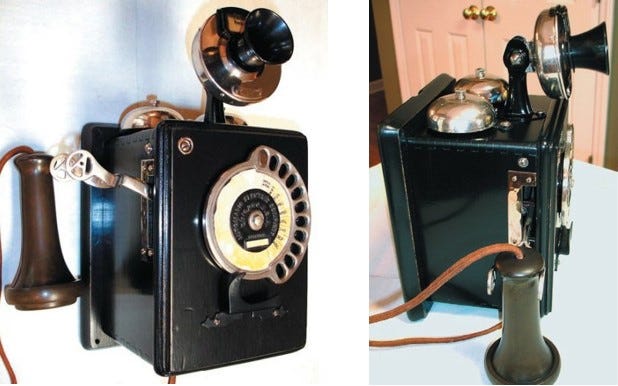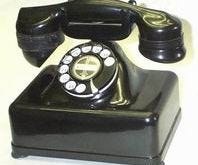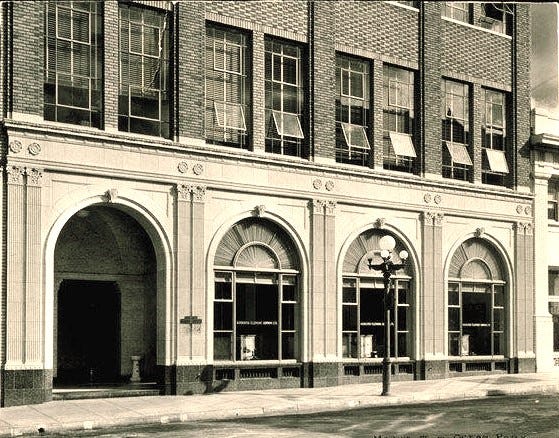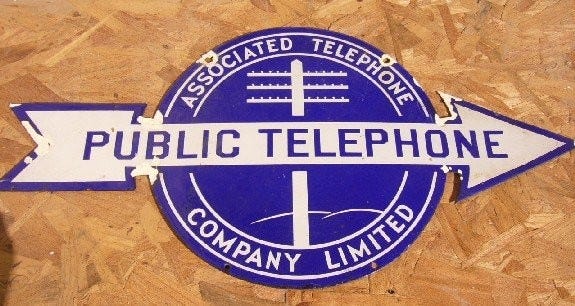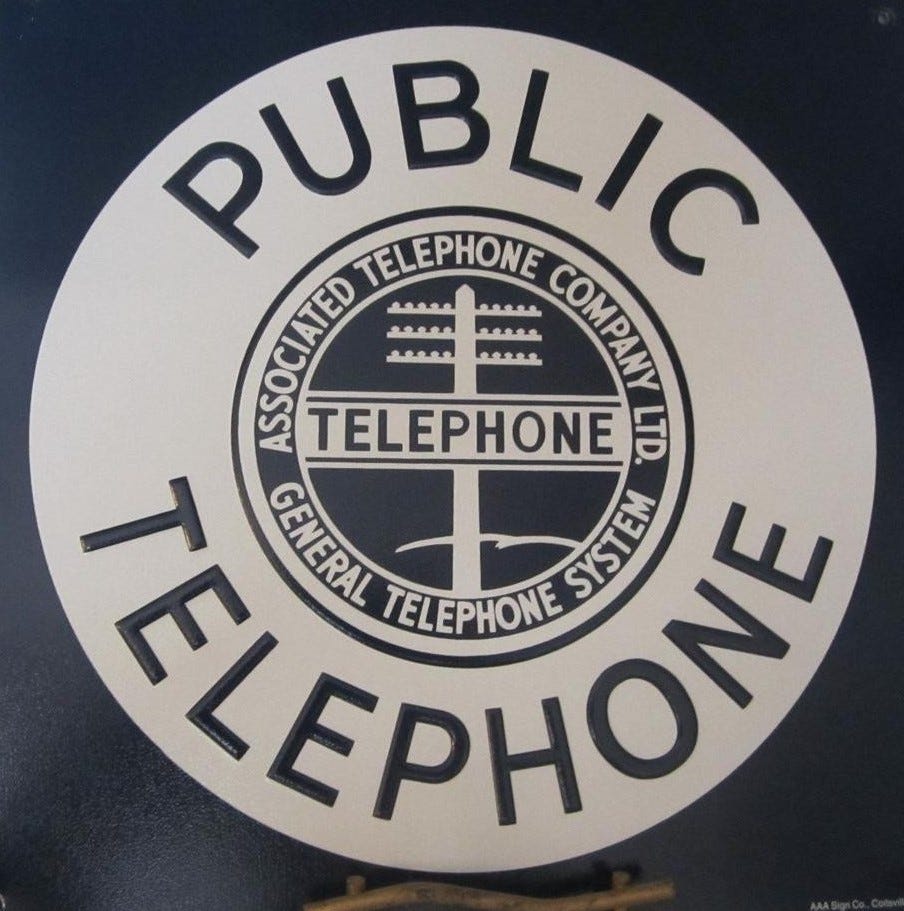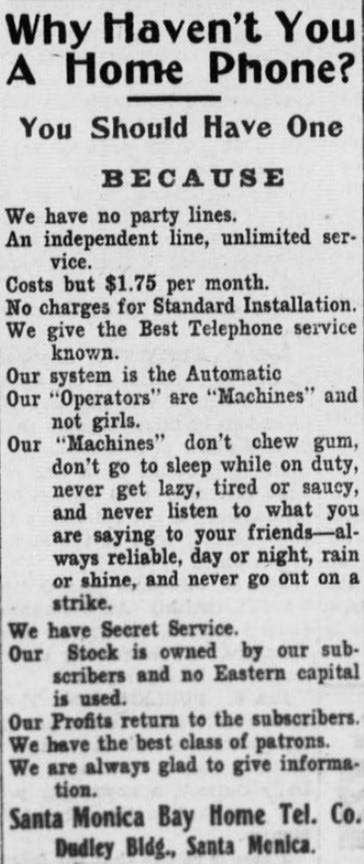In 1894, Sunset Telephone obtains a Santa Monica telephone franchise, followed in 1905 by Home Telephone. In 1918, the two incompatible systems consolidate - businesses and residents no longer have to have two lines and two telephones.
Between 1876 and 1894, the Bell Telephone Company, named for its affiliation with Alexander Graham Bell (1847 - 1922), holds a wide-reaching and controversial patent on telephony that essentially prevents all competition.1 When the Bell patents expire in 1894, doors open to independent providers (private investors), who compete with Bell (which becomes AT&T in 1885). Parallel systems are created that lead to often bitter competition and chaos.
In 1894, Sunset Telephone and Telegraph Company obtains a 25-year home telephone franchise in Santa Monica. Sunset is acquired by Pacific Telephone & Telegraph Company, a Bell System company, but continues to use the Sunset name. There are complaints about the service, but Sunset holds a virtual monopoly on telephone service for the rest of the 1800’s - competitors encounter political and regulatory hurdles.
In 1905, the City of Santa Monica awards a competing 50-year franchise to Home Telephone and Telegraph Company of Santa Monica and Ocean Park.2 In 1907, the company, now serving Santa Monica, Ocean Park, Venice and Sawtelle, is re-organized as Santa Monica Bay Home Telephone Company.3
By 1918, Pacific Telephone & Telegraph Company (Sunset - a 2-wire manual4 system) and Santa Monica Bay Home Telephone Company (Home - a 3-wire automatic5 system) each have about 2,000 subscribers. The two systems are incompatible - requiring businesses and residents to have two lines and two telephones. Both companies claim to be losing money. Subscribers are dissatisfied with the service. The Sunset franchise is set to expire in 1921.
In 1918, Santa Monica Bay Home Telephone Company (Home) purchases the local assets of competitor Pacific Telephone and Telegraph Company (Sunset) and consolidates the two systems into an entirely new 2-wire automatic system. By 1923, two new exchanges have been completed. A main line costs $2.75/month, a 2 party line $2.25/month, a 4 party line $2.00/month and the 10 party line is abolished.
In 1925, a business syndicate6 buys Santa Monica Bay Home Telephone Company, and the company is re-organized as Santa Monica Bay Telephone Company ("home" left off) - serving Santa Monica, Ocean Park, Venice, Playa Del Rey, Brentwood, Westgate, Sawtelle and Bel Aire. With 12,0007 subscribers, it is the West Coast's largest independent telephone company.
In 1926, Santa Monica Bay Telephone Company builds a 4-story headquarters and exchange building at 155 Marine St - directly behind their 160 Pier Ave offices. The independent United States Long Distance Telephone Company8 is located in the adjacent First National Bank of Ocean Park building.
In 1928, Santa Monica Bay Telephone Company is acquired by Associated Telephone Company.9
In 1933, following the stock market crash of 1929, Associated Telephone Company is forced into receivership.10 In 1934, the re-organized Associated Telephone Company, now a unit of General Telephone Corporation, moves its headquarters to a 2-story building in Long Beach.
In 1937, the Associated Telephone Company builds a 4-story headquarters building in Santa Monica that serves as the principal telephone exchange facility for the Bay District between 1937 and 1956.

In 1938, Associated Telephone Company installs the 100,000th Automatic Electric Monophone Model 34 at the Santa Monica home of Shirley Temple.
In 1953, Associated Telephone Company is renamed General Telephone Company of California.11 In 1971, General Telephone Company of California moves its corporate headquarters to the 100 Wilshire building. In 1985, General Telephone, citing rising commercial and residential real estate costs in Santa Monica, where it is the city’s largest private employer, relocates to Thousand Oaks.
In August of 2022, the Federal Communications Commission (FCC) rules that telephone companies are no longer required to provide copper landline service.12
Early telephone service is limited to a small number of affluent subscribers. A separate direct point to point line has to be installed for each person to be contacted. The telephone switchboard, invented in 1878, allows for many telephones to be connected at a single, central a telephone exchange - making telephony practical and ushers in a wave of new telephone subscribers. Operators manually connect calls by plugging into the jack of the party to whom the caller wishes to speak.
Home Telephone and Telegraph Company of Santa Monica and Ocean Park directors are T.H. Dudley, W.S. Vawter, H.S. McKee, H.H. Sinclair, and Louis Blankenhorn. Dudley and Vawter are Santa Monica City Trustees. The company has offices in the Dudley Building (231 Santa Monica Blvd at 3rd St) and at 160 Pier Ave in Ocean Park. A list of subscribers and 4-digit telephone numbers is published in the daily newspaper.
Santa Monica Bay Home Telephone Company directors are T.H. Dudley, W.S. Vawter, L. Blankenhorn, B.O. Kendall, and L.C. Torrance. Lewis Curtis Torrance (1855 – 1926) is president (Torrance’s brother, Jared Sidney Torrance (1853 – 1921), is the founder of Torrance).
The Bell system ‘Hello Girls’ strike for fair treatment and higher wages in 1907.
In the early 1900’s, Pacific Telephone & Telegraph (Sunset), along with the rest of the Bell System, resists automating its services, on the premise that their people provide better service than machines. When Bell acquires competing providers with automatic service, it replaces them with manual systems. However Bell’s manual systems are unable to keep up with the growing demand for telephone service, and in the early 1920s, the Bell companies begin installing automated systems.
Almon Strowger (1839 - 1902), a Kansas City undertaker, invents the first automatic telephone exchange in 1889, and founds Automatic Electric to manufacture exchange equipment and customer telephones for independent telephone companies.
The Santa Monica Bay Telephone Company syndicate is organized by John Griffin Mott (1874 – 1942). Charles Frederick Mason (1882 - 1956) is General Manager. The company has more than 100 employees with offices at 160 Pier Ave (serving 3,600 telephones) and at 1324 7th St (serving 5,100 telephones). In 1924, the same syndicate purchases the Redondo Home Telephone Company – serving Redondo Beach, Hermosa Beach, and Manhattan Beach.
Early telephone exchanges use subscriber names for the switchboard operator to connect. Telephone numbers, where every telephone set is assigned a number, are first used in 1879. The exchanges soon run out of 4-digit numbers (NNNN). In the 1920s, Associated Telephone numbers have 6 digits (NNNNNN), and in 1950, it adopts the US standard 7-digit format (LLN-NNNN two letters, five numerals). To aid memorization, the first two digits use mnemonic exchange names - EX(brook) in Santa Monica.
In the late 1950’s, telephone systems begin switching to all-number calling, which doesn't rely on archaic telephone exchanges, and can exponentially add customers just by introducing new area codes. The change does not happen without some resistance - people love the literary charm of their old telephone exchange names. Groups like the Anti-Digit Dialing League and the Committee of Ten Million to Oppose All-Number Calling are formed to protest.
1894 sees the first telephone conversation between San Francisco and Los Angeles, and in 1915, the first New York to San Francisco telephone call is made. Sunset has its own long distance service via the Bell system; while the Home company is only equipped to offer local service.
For long distance connections, Home uses the independent United States Long Distance Telephone & Telegraph Company. Despite this grandiose name, the company has limited reach. Subscribers being unable to make calls to beyond Northern California or any other state. If someone calls into the switchboard requesting to speak with someone outside of that central office’s dominion, the operator contacts the telephone exchange office in the area where the person the caller was trying to reach is located. This is considered a long distance call and additional fees are required.
After the 1912 pier fire, United States Long Distance Telephone Company moves offices from the Decatur building to the 2nd floor of the First National Bank of Ocean Park building. In 1927, the company has 27 operators handling an average of 2,500 calls per day - of which 97 percent are completed - which is considered a remarkable achievement.
Sigurd L. Odegard (1885 – 1934) begins acquiring Wisconsin independent telephone companies in 1918. In 1920, Odegard organizes the Associated Telephone Company to hold purchased telephone systems in Long Beach and San Bernardino. From 1926 – 1929, Associated Telephone Company purchases telephone systems in Pomona, Baldwin Park, Azusa, Covina, Ontario, Upland, Santa Monica, and Westwood. Santa Monica Bay Telephone Company’s general manager, Charles F. Mason, becomes vice-president of Associated Telephone Company.
Between 1926 and 1933, Associated Telephone Utilities acquires over 300 telephone companies across the US. Following the stock market crash of 1929 and the Great Depression that followed, the company is forced into receivership in 1933. The company emerges in 1934, re-organized, together with several other independent telephone companies, as General Telephone Corporation. Charles F. Mason becomes president of Associated Telephone Company - the largest unit of General Telephone Corporation.
General Telephone Corporation (renamed General Telephone & Electronics Corporation, or GTE, in 1959) is headquartered in New York City. Associated Telephone Company’s name change conforms with General Telephone Corporation’s branding of its 12 subsidiary companies nationwide. In 2000, GTE and Bell Atlantic merge to become Verizon Communications.
Previously, communications companies have been required to provide landline telephone services unbundled from other services - at a rate regulated by the federal government. The communications companies are able to convince the FCC that its rules are too burdensome and interfere with the transition to more modern communications technology, such as far cheaper and more durable, fiber optic cable.



